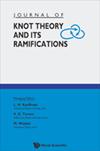基于非极小实现的新型超级桥梁指标计算
IF 0.4
4区 数学
Q4 MATHEMATICS
引用次数: 0
摘要
先前的工作[21]使用节点的多边形实现,将计算实现的超级桥数的问题简化为线性规划问题,从而导致多个节点的超级桥指数出现新的尖锐上界。目前的工作将这项技术扩展到具有奇数边的多边形实现,并确定了许多新节点的精确超桥指数,包括之前未知的大多数9个交叉节点,以及首次确定的几个12个交叉节点。有趣的是,这些超级桥最小化多边形实现中至少有一半没有最小化结的棒数;这些似乎是第一个这样的例子。附录A完整总结了目前已知的10个交叉口的主要节点的超级桥梁指数,附录B给出了已知超级桥梁指数的16个交叉口中的所有节点。本文章由计算机程序翻译,如有差异,请以英文原文为准。
New Superbridge Index Calculations from Non-Minimal Realizations
Previous work [21] used polygonal realizations of knots to reduce the problem of computing the superbridge number of a realization to a linear programming problem, leading to new sharp upper bounds on the superbridge index of a number of knots. The present work extends this technique to polygonal realizations with an odd number of edges and determines the exact superbridge index of many new knots, including the majority of the 9-crossing knots for which it was previously unknown and, for the first time, several 12-crossing knots. Interestingly, at least half of these superbridge-minimizing polygonal realizations do not minimize the stick number of the knot; these seem to be the first such examples. Appendix A gives a complete summary of what is currently known about superbridge indices of prime knots through 10 crossings and Appendix B gives all knots through 16 crossings for which the superbridge index is known.
求助全文
通过发布文献求助,成功后即可免费获取论文全文。
去求助
来源期刊
CiteScore
0.80
自引率
40.00%
发文量
127
审稿时长
4-8 weeks
期刊介绍:
This Journal is intended as a forum for new developments in knot theory, particularly developments that create connections between knot theory and other aspects of mathematics and natural science. Our stance is interdisciplinary due to the nature of the subject. Knot theory as a core mathematical discipline is subject to many forms of generalization (virtual knots and links, higher-dimensional knots, knots and links in other manifolds, non-spherical knots, recursive systems analogous to knotting). Knots live in a wider mathematical framework (classification of three and higher dimensional manifolds, statistical mechanics and quantum theory, quantum groups, combinatorics of Gauss codes, combinatorics, algorithms and computational complexity, category theory and categorification of topological and algebraic structures, algebraic topology, topological quantum field theories).
Papers that will be published include:
-new research in the theory of knots and links, and their applications;
-new research in related fields;
-tutorial and review papers.
With this Journal, we hope to serve well researchers in knot theory and related areas of topology, researchers using knot theory in their work, and scientists interested in becoming informed about current work in the theory of knots and its ramifications.

 求助内容:
求助内容: 应助结果提醒方式:
应助结果提醒方式:


